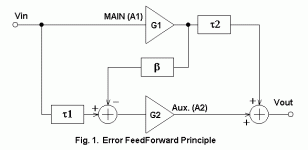A simple example for feedforward in audio would be the power supply compensation used in some open-loop Class-D units. Since these do not use a feedback loop (i.e. have a PSRR = 0dB), the supply variations need to be fed forward into the audio input with the opposite polarity, so that they don't show up at the output.
Another (not very obvious) example would be the output ripple steering technique used in Class-D amps (below). It is feedforward because the ripple is removed using knowledge about itself (predicted using the pulse-width).
https://www.extron.com/article/classdaudioamp_ts
Then there's also the example of the pre-warping function used in bilinear transform (DSP). Again, this works because the frequency warping is already known to be a tangent function and therefore an inverse tangent maybe readily applied (pre-warp) to counter its effect.
https://en.wikipedia.org/wiki/Bilinear_transform#Frequency_warping
Another (not very obvious) example would be the output ripple steering technique used in Class-D amps (below). It is feedforward because the ripple is removed using knowledge about itself (predicted using the pulse-width).
https://www.extron.com/article/classdaudioamp_ts
Then there's also the example of the pre-warping function used in bilinear transform (DSP). Again, this works because the frequency warping is already known to be a tangent function and therefore an inverse tangent maybe readily applied (pre-warp) to counter its effect.
https://en.wikipedia.org/wiki/Bilinear_transform#Frequency_warping
Last edited:
The whole point of feedforward is that there is no loop, surely? Adding a loop affects stability which is why feedback has to be done with care.
You could argue that differential signals are a form of feed-forward as the common-mode disturbance to the cable is cancelled by the differential receiver, but thats very debatable.
You could argue that differential signals are a form of feed-forward as the common-mode disturbance to the cable is cancelled by the differential receiver, but thats very debatable.
Just the ubiquitous one?
https://digilander.libero.it/paeng/feedforward_concepts.htm
https://digilander.libero.it/paeng/feedforward_concepts.htm
Attachments
https://www.edn.com/feed-forward-principle-cancels-waveform-distortion/
https://benchmarkmedia.com/blogs/application_notes/feed-forward-error-correction
http://www.renardson-audio.com/classbff.html
https://linearaudio.nl/feedback-feedforward-error-correction
https://www.diyaudio.com/community/threads/simple-feed-forward-error-correction-amp.330305/
https://www.dadaelectronics.eu/uplo...plifiers-AES-1980-J-Vanderkooy-S-Lipshitz.pdf
Found some good reading. Enjoy!
https://benchmarkmedia.com/blogs/application_notes/feed-forward-error-correction
http://www.renardson-audio.com/classbff.html
https://linearaudio.nl/feedback-feedforward-error-correction
https://www.diyaudio.com/community/threads/simple-feed-forward-error-correction-amp.330305/
https://www.dadaelectronics.eu/uplo...plifiers-AES-1980-J-Vanderkooy-S-Lipshitz.pdf
Found some good reading. Enjoy!
Boy that sounds familiar @tomchr lolwhich is Vout = A*Vin
They do different things - feedback can drive integrated error down to zero over time for instance, the classic DC-servo for example. Feed-forward can be added without risk to stability. Feedforward is typically much less accurate than feedback can attain. Feedforward does nnothing about disturbances it doesn't know about, feedback tackles any disturbance.I guess the part that I don't get is: it seems like a lot of things you can do in feedforward you can implement in feedback much easier. Is there any benefit to using a feedforward technique as opposed to a feedback one?
They can complement each other.
Feedforward can sometimes improve performance, depends. One example is shown in block diagram format:

The point is that it possible to help compensate for errors that you know are going to happen, and the technique may do it without affecting stability. The approach can help reduce how much work a feedback loop has to do, and possibly help performance given the limitations of feedback loop gain and response time.
The point is that it possible to help compensate for errors that you know are going to happen, and the technique may do it without affecting stability. The approach can help reduce how much work a feedback loop has to do, and possibly help performance given the limitations of feedback loop gain and response time.
By that rationale, wouldn't that include a lot of prior testing in order to implement it? Or is that why you would use feedback alongside it?The point is that it possible to help compensate for errors that you know are going to happen,
Depends on what you know about the system/plant (sometimes its referred to as a 'plant' in control literature). If you know some correction will be needed, you can go ahead and give your best estimate to the output processing. Whatever error remains after that is all the feedback loop needs to correct for.
To understand the system dynamics in the first place, there is something called 'system identification.'
https://www.amazon.com/Principles-S...Theory-Practice/dp/1439895996#customerReviews
To understand the system dynamics in the first place, there is something called 'system identification.'
https://www.amazon.com/Principles-S...Theory-Practice/dp/1439895996#customerReviews
Nice topic, and I agree with Tom: applying FF alone is spitting on Murphy, FF along with (N-)FB is very delicate. In the examples provided above, most are rather specific in their application, or somewhat limited. It is certainly not the broad whitening brush that serves all.The trick is to make the feedforward and feedback work together while having a stable system. That's not an easy task.
Tom
I'm preparing a paper about 'the illusion of controlled feedback' (active feedback with an amplifier in that 'feedpart' of the loop), but the conclusion sofar is that not the amplifier (the one) with errors determines the overall function, but the topology of the correction parts in the FF/FB-loop, being either FF or FB! A non-inverting opamp will do invert the input signal with an inverting opamp in its feedback loop, to meet the stability conditions, which is counterintuive. It also hints to the cause of instability, due to stray capacitances, its phase shifts and the swapping of an amplifier into an oscillator (and vv). There are eight positions to tackle with FB only, FF will add an extra 8 more, but those are beyond my scope.
FF has the tendency to 'predict' the final error, but only to a certain level. That can be fruitfull (links in #12!), but again, it is shoving the dust under the carpet, not eliminating the errors (distortion) completely. Though, either approach (FF/FB) has its merits.
- Home
- Design & Build
- Electronic Design
- Feedforward Loops
